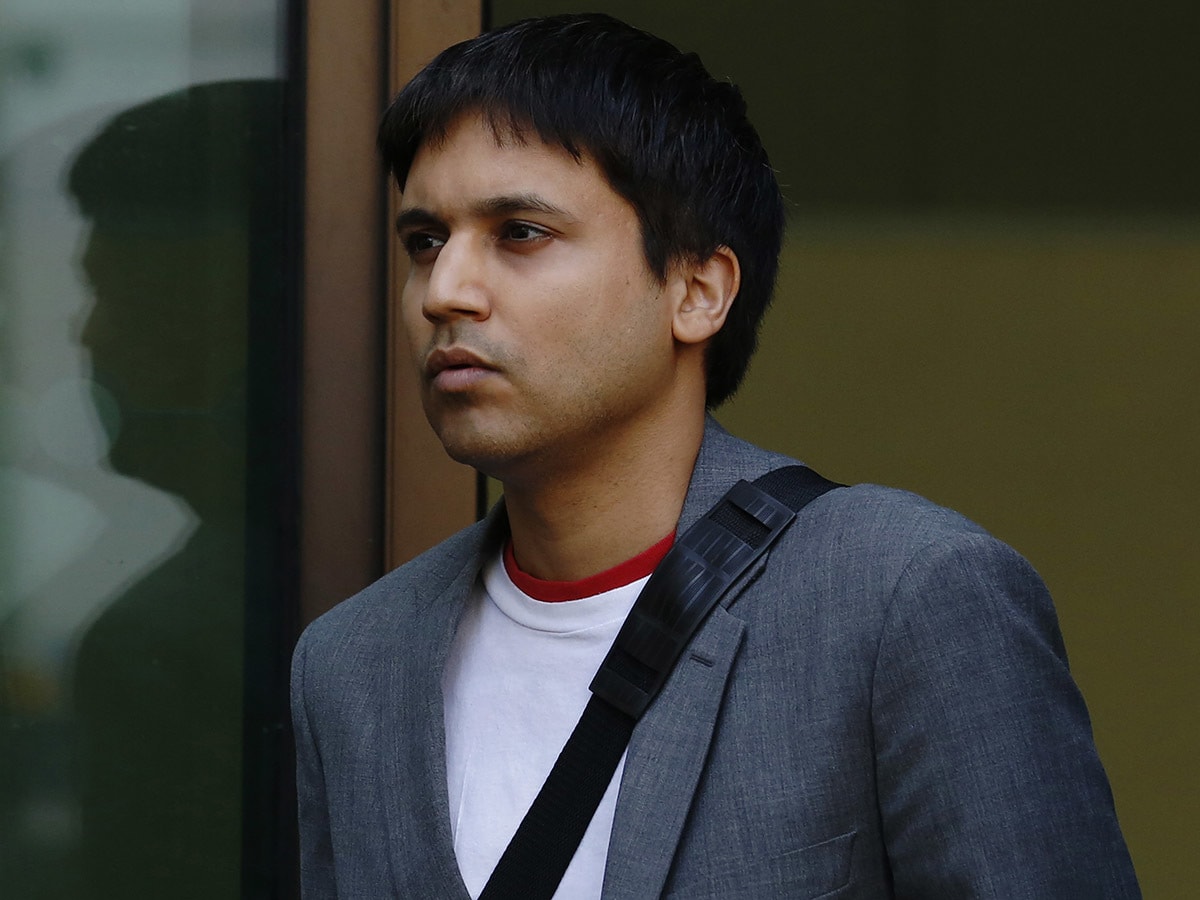Navinder Singh Sarao’s supporters will relish the irony. Weeks after the British day trader was effectively sent to his childhood bedroom like a naughty child for helping wipe $1trn off the world’s stock markets in under 10 minutes, Covid-19 lockdown has meant everyone else — including those who had relentlessly pursued him for a decade — have also now been sent to theirs.
Ordinarily the 22 counts of fraud originally levelled against Sarao — which included the relatively new type of market spoofing (placing then quickly cancelling orders) — might have carried a sentence of 380 years in jail.
But, far from being an avaricious criminal mastermind, Sarao was revealed in a Chicago court to be unmotivated by money. He had played the futures markets in his bedroom at his parents’ home in west London, like one of his favourite video games.
$1trillion
Amount wiped off global stock markets in under 10 minutes
Sarao and the flash crash
Such was the empathy for Sarao that fellow traders offered to pay his court fees and the US Federal Reserve insisted it did not want a prison sentence.
This combination of factors, plus the fact that he made not a single ostentatious purchase with his over $45m fortune (subsequently losing millions to fraudulent investors himself and, perhaps his greatest mitigation, willingly showing the market authorities the tricks of his trades to stop others doing the same) gave him the lenient sentence of one year’s house arrest.
It’s been 10 years since Sarao helped wipe out $1trn in that same Hounslow house — an extraordinary tale told in a new book by Bloomberg journalist Liam Vaughan. Flash Crash: A Trading Savant, A Global Manhunt and The Most Mysterious Market Crash in History, reveals how its subject developed the trading obsession that led to his downfall.
Despite the British press nicknaming Sarao the “Hound of Hounslow”, he bears no relation to the Wolf Of Wall Street Jordan Belfort. But he is clearly an exceptionally talented man.
Following a directionless year after graduating from university, in 2002 Sarao answered a newspaper ad for trainee traders at Futex, a so-called arcade firm (as all its trades were done on computers) with offices above the Weybridge branch of Waitrose. Here execs at the company taught trainee traders, backing the successful ones with larger sums and making money from a share of their profits.
Most failed but the job fitted Sarao like a glove. His extraordinary ability to hold a series of numbers in his head (he had learned his times tables by the age of three) and lightning-fast reactions honed on computer games (at one point he was ranked in the top 700 of the football computer game FIFA’s three million players worldwide) made him brilliant at scalping — where a trader constantly buys and sells as markets shift, never holding a position for more than a few seconds.
Former Futex colleague Leif Cid later compared him to “one of the robots in Westworld or Neo from The Matrix. He didn’t just observe the market. He was inside it.”
“He didn’t just observe the market. He was inside it” - Former Futex colleague, Leif Cid speaking about Sarao
Sarao left Futex in 2008 worth £2m. A year later, working in his bedroom, he was worth £12m — but he was becoming frustrated. The emergence of algorithm-based high-frequency trading (HFT) models on ultra-fast computers that could react even quicker than he did cut his profits.
“If you can’t beat ’em, you may as well join ’em, eh?” he wrote bitterly and anonymously on an online trading forum under the avatar of the Joker. Sarao had realised most major HFT players were using very similar software, which would react identically, so he hired a developer to build a program to fool the HFT firms by sending false signals into the market through the Chicago Mercantile Exchange.
Using software as a service
Over the next few months, he used this software to regularly deploy two techniques — spoofing and layering. Sarao would place orders, then modify and cancel them, cashing in by buying contracts at the artificially low price and selling them when the market corrected.
This did not go unnoticed. On 6 May 2010, the morning of the flash crash, Sarao received a third warning from CME Group about his futures trading behaviour. The warnings didn’t faze him — he subsequently told his brother he’d called the CME “and told ’em to kiss my ass”. More pertinently, he began trading on that day with exactly the same techniques.
Before the flash crash, Sarao placed six e-mini orders, which were replaced or modified 19,000 times before he cancelled them without completing a single trade. Their $200m value made up just over a quarter of the entire sellside of the order book for e-mini contracts on CME.
At 2.45pm the Dow, which had already been impacted by concerns about the Greek debt crisis and uncertainty over that day’s UK general election, suddenly plummeted nearly 1,000 points in 10 minutes. But by just after 3pm it had bounced back and ended the whole day just 3% down.
1,000
Number of points the Dow dropped by in 10 minutes
Immediately inquests began. An investigation by the US Securities and Exchange Commission found the crash was triggered by a single selling order of an enormously large number of e-mini S&P contracts, followed by aggressive selling orders launched by HFT algorithms.
But it was five years before investigators finally closed in on Sarao, who had not only made £716,000 on the day, but continued trading so successfully that he had made £40m by the time police turned up with a warrant at his parents’ house on 20 April 2015.
He was arrested and charged with manipulating the markets, but his fortune was so complexly tied up in offshore schemes that he couldn’t find the £5m bail. He spent four months on remand in Wandsworth prison before his lawyers reached a bail deal with the US Justice Department.
£40million
Amount Sarao had made before being arrested
Charges dropped
All but two of the original 22 charges were eventually dropped, and Sarao, who admitted one count of electronic fraud and another of spoofing, was handed his lenient sentence. This was due in part to empathy for his autism, partly because he had paid back £9.9m prosecutors claimed he had earned illegally. He was also so clearly unmotivated by wealth that his largest single purchase was a £5,000 car.
The Commodity Futures Trading Commission concluded that Sarao “did not cause the flash crash” — although it did maintain he was “at least significantly responsible for the order of imbalances” that exacerbated it. Academic studies have also shown that at least one flash crash — albeit not anywhere near as dramatic — hit the markets every year from 1993-2011.
Part of the legacy of Sarao’s brief but spectacular career is increased regulation and the implementation of circuit breakers, which halt trading for five minutes on any S&P stock whose value fluctuates more than 10% in a five-minute period.
As for Sarao himself, the Hound of Hounslow remains a person of interest. Robert Harris’s 2011 novel The Fear Index was based on the 24-hour period around the 2010 flash crash, and Vaughan’s book is to be made into a film starring Dev Patel.
Sarao’s lawyer Roger Burlingame told the court in November that all Sarao’s assets “have been stolen” after what turned out to be naive investments of his assets proved impossible to recover. “Basically,” said Burlingame, “he has some extraordinary abilities with respect to pattern recognition and certain sorts of mathematical abilities, but he has some fairly severe social limitations."
So the markets recovered and the curious tale of Navinder Singh Sarao ends where it began, in his bedroom at his family home, in front of a computer. But now, presumably, all he’s playing is FIFA.
“Basically he has some extraordinary abilities with respect to pattern recognition and certain sorts of mathematical abilities, but he has some fairly severe social limitations” - Sarao’s lawyer Roger Burlingame
Disclaimer Past performance is not a reliable indicator of future results.
CMC Markets is an execution-only service provider. The material (whether or not it states any opinions) is for general information purposes only, and does not take into account your personal circumstances or objectives. Nothing in this material is (or should be considered to be) financial, investment or other advice on which reliance should be placed. No opinion given in the material constitutes a recommendation by CMC Markets or the author that any particular investment, security, transaction or investment strategy is suitable for any specific person.
The material has not been prepared in accordance with legal requirements designed to promote the independence of investment research. Although we are not specifically prevented from dealing before providing this material, we do not seek to take advantage of the material prior to its dissemination.
CMC Markets does not endorse or offer opinion on the trading strategies used by the author. Their trading strategies do not guarantee any return and CMC Markets shall not be held responsible for any loss that you may incur, either directly or indirectly, arising from any investment based on any information contained herein.
*Tax treatment depends on individual circumstances and can change or may differ in a jurisdiction other than the UK.
Continue reading for FREE
- Includes free newsletter updates, unsubscribe anytime. Privacy policy





